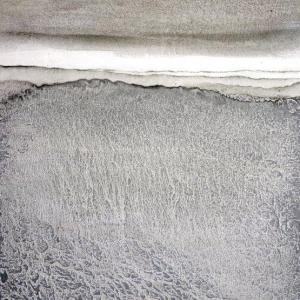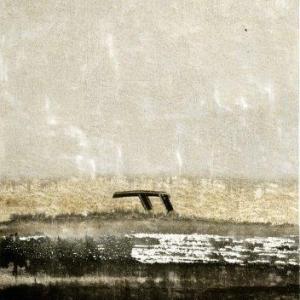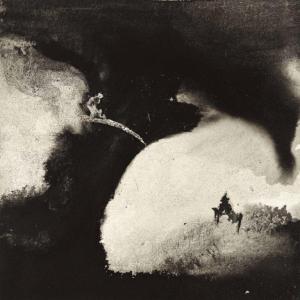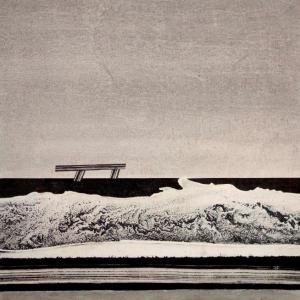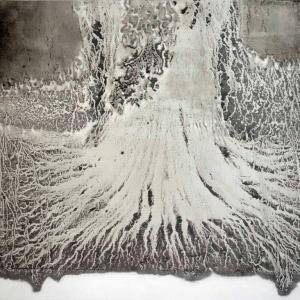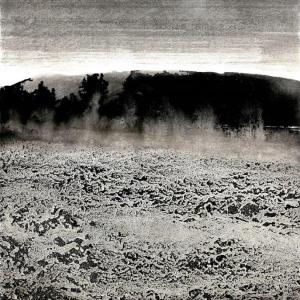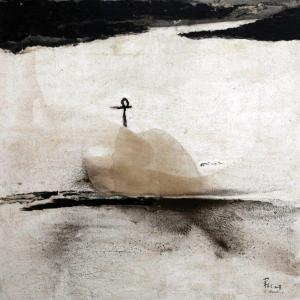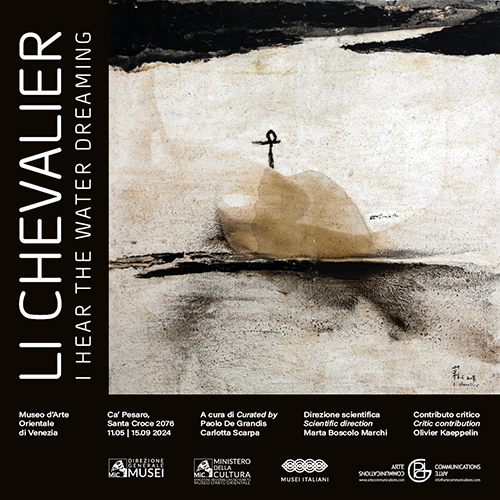
LI CHEVALIER
I Hear the Water Dreaming
Curated by Paolo De Grandis and Carlotta Scarpa
Under the scientific direction of Marta Boscolo Marchi
And with critical contributions by Olivier Kaeppelin and Tao Wang
Museum of Oriental Art
Ca’ Pesaro, Santa Croce 2076 – Venice
1 May – 15 September 2024
Tuesday – Sunday: 10.00 - 18.00
The Museum of Oriental Art in Venice offers its visitors an extraordinary encounter with the creative universe of French-Chinese artist Li Chevalier.
I Hear the Water Dreaming is a solo exhibition, curated by Paolo De Grandis and Carlotta Scarpa, celebrating Li Chevalier's intense artistic career through a selection of thirty ink-on-canvas works as a tribute to Venice, the city that changed the artist's expressive path in the early 1990s.
Born in China but raised in Europe since the 1980s, she graduated in Philosophy from the Sorbonne University in Paris and was a singer in the chorus of the Orchestre De Paris. Li Chevalier feels a strong connection to Venice since it was in the lagoon city that she took her first lesson in Italian language in order to perform bel canto to the best of her ability. Shortly afterwards, fascinated by beauty and art, she began her extensive art education first in Venice, then in Florence and Rome, exploring drawing, engraving and classical painting until she completed a post-graduate degree in contemporary art at Central Saint Martins College of Art and Design in London.
Living and working between Europe and Asia, Li Chevalier has chosen to reinterpret the technique of ink painting, an ancient Chinese medium often confined to a historical academic vision. This return to Chinese tradition was a choice aimed at “comparing Eastern plasticity with contemporary and European painting techniques”.
Her paintings on canvas are a harmonious and innovative combination of Chinese ink and the very essence of composition and materials specific to European painting: canvas, collage, texture. This pairing reveals her constant attention and reflection in comparing Eastern aesthetics cultivated over centuries with a world-view of doubt and redemption, humanism and solitude, which draws heavily on the sources of Western philosophy.
A former singer with the Peking Opera, Li Chevalier does not create without putting music at the centre of each of her exhibition projects. The title of the exhibition I Hear the Water Dreaming is directly inspired by the piece by the Japanese composer Tōru Takemitsu, but it is also a homage to the winter mist of the Venetian lagoon that transports us to a musical tone full of mystery and silence where the lyricism of the dreaming water covers every canvas. There is a direct parallel between the historic composer and Li Chevalier: both operate on a vast cultural fabric to the point of absorbing influences from both the western and eastern worlds, just as both develop an increasingly personal language without ever lapsing into a trivial juxtaposition of genres or techniques. Takemitsu’s own research also extends to poetry, painting and calligraphy, and the concept of emptiness/silence (Ma), between one sound event and another, creates evocative moments of suspense that can be found in Li Chevalier's silent spatial fields.
The exhibition is developed with a site-specific installation that dialogues with the Collection of the Museum of Oriental Art in Venice, one of the largest collections of Asian art in Italy. The exhibition halls, located on the third floor of Ca' Pesaro since 1928, combine, today as in the past, the juxtaposition of Asian works with the private spaces of a Rococo residence, in a highly evocative ensemble in which temporary exhibitions alternate, enriching the collection with previously unseen artistic contributions, such as on the occasion of Li Chevalier's exhibition. The latter benefits from the important scientific direction of Marta Boscolo Marchi, Director of the Museum of Oriental Art, and the authoritative academic contribution of Olivier Kaeppelin, art critic and curator, Director of the Maeght Foundation and President of the Palais de Tokyo, and Tao Wang, Chinese art critic and curator, Director of the Asian Art Department at the Art Institute of Chicago.
In the current climate of tension, mistrust, brutality and intolerance that darkens our present, Li Chevalier's art offers a delicate and reflective artistic vision that gratifies our senses with a poetic atmosphere. Finally, the exhibition offers an encouraging cross-cultural approach that deserves a chapter of its own in the history of ink painting in the 21st century, written by Chinese artists abroad, enraptured by new cultural encounters.
Biographical note
Li Chevalier, born 1961 in Beijing, is a French-Chinese painter and multimedia artist. A graduate of the Central Saint Martins College of Art & Design in Fine Arts in London, she is a leading figure among women of her generation who are very active on the international art scene. Chevalier's career is built around an exceptional intercontinental journey, characterised by a transcultural and multidisciplinary aesthetic universe, developing an art whose signature has a passionate relationship with the world of music. Over the past ten years, Li Chevalier's works have been shown in numerous museums in Asia and Europe, including: the Saatchi Gallery, London 2023; the Musée des Arts Asiatiques in Nice, "Paysage de l'âme", Nice, 2022; the Museum of Contemporary Art Rome (MACRO), "Trajectory of Desire", 2017; the Base Sous Marine de Bordeaux, "L'Art du croisement", 2014; the National Opera of China, "Symphonie visuelle", 2013; the National Library of China, "Stéles et V. Segalen", 2012; the Shanghai Museum of Fine Arts, "L'Orient poétique", 2011; the National Museum of Fine Arts of China, "Contempler l'Orient", 2010; the Central St Martins College of Arts and Design, London, "A la recherche de la beauté perdue", 2007; the Virginia Commonwealth University School of the Arts, "Silence voilée", USA-Qatar, 2001. Since 2011, two important paintings by the artist have adorned the reception room of the French Embassy in China, alongside works by Zao Wouki and Chu Tequn.
